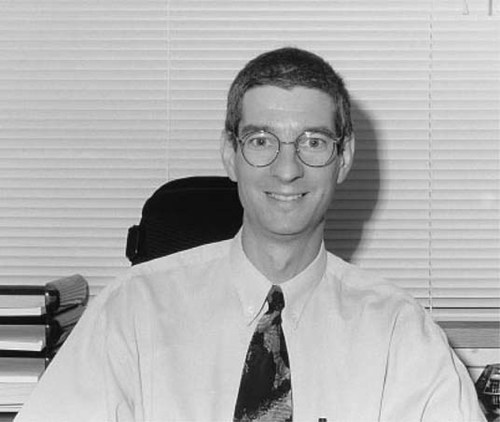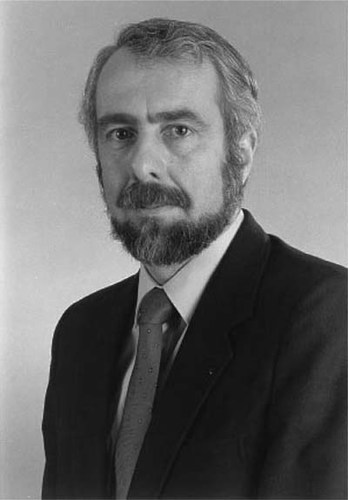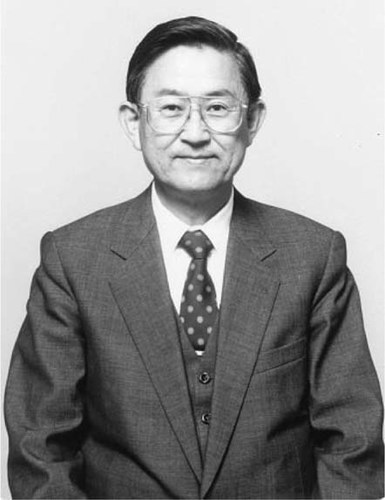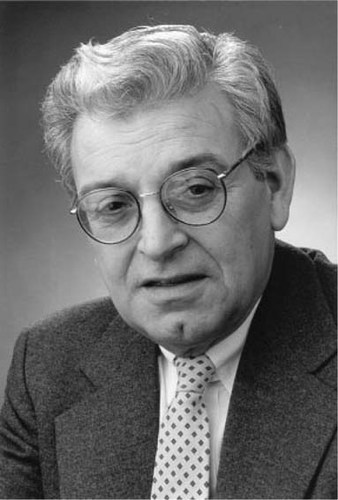American Society for Bone and Mineral Research Annual Meeting 1997: Fuller Albright Award, Frederic C. Bartter Award, William F. Neuman Award, Shirley Hohl Service Award
THE FULLER ALBRIGHT AWARD
Fuller Albright, M.D., was a much beloved investigator and teacher whose unparalleled achievements include significant contributions to the study of the renal effects of parathyroid hormone, estrogen use in osteoporosis, Vitamin D resistant rickets, and establishment of the Endocrine Unit of the Massachusetts General Hospital. The Fuller Albright Award is given in recognition of meritorious scientific accomplishment in the bone and mineral field by an individual who has not yet reached his or her 41st birthday. In September, 1997, the Fuller Albright Award was presented to René St-Arnaud, Ph.D., Assistant Professor of Experimental Surgery at McGill University, Montreal, Canada, and a Senior Staff Scientist at the Shriners Hospital for Crippled Children. The Fuller Albright Award was sponsored by Hoechst Marion Roussel, Inc.

René St-Arnaud, Ph.D.
Dr. René St-Arnaud was born in Montreal, Canada. After completing his undergraduate work at the University of Montreal, he obtained his Ph.D. from Laval University in Quebec. Dr. St-Arnaud's postdoctoral training at the University of Ottawa and at the State University of New York at Stony Brook concerned the control of proto-oncogene expression during cell differentiation. He quickly recognized the link between this and bone cell function, and was the first to demonstrate that vitamin D can increase c-fos expression in bone cell cultures. These studies led to the identification of a novel structure for a vitamin D response element and identification of a link between the levels of c-fos expression and the molecular etiology of fibrous dysplasia.
Dr. St-Arnaud's current research centers on the control of gene expression in bone cells and the role of calreticulin, in biomineralization, structure-function relationships in a novel transcriptional coactivator specifically expressed in developing bone, and the role of vitamin D in bone disease.
His work on calreticulin illustrates that a gain-of-function mutation for the protein impairs mineralization in vitro. In a parallel study, the loss-of-function mutation reveals an essential role for the protein in integrin-dependent calcium signaling. Dr. St-Arnaud's work has led to the identification of a coactivator protein mediating c-jun-dependent transcription and revealed that it is specifically expressed in osteoblasts at centers of ossification during development, suggesting a role in the regulation of osteoblastic differentiation and bone development.
His research on vitamin D metabolism has resulted in two major novel findings. He was successful in cloning the long sought after 25-hydroxyvitamin D-1α-hydroxylase and demonstrating that it maps to the disease locus for pseudovitamin D-deficiency rickets. Additionally, he has been the first investigator to generate a 24-hydroxylase knockout mouse, confirming the role of the 24-OHase gene in the catabolism of vitamin D and revealing a surprising apparent function in bone development for 24,25(OH)2D products. These exciting observations are certain to clarify the role of vitamin D 24-hydroxylation and provide the entire field with a tremendously valuable animal model.
Dr. St-Arnaud's landmark accomplishments represent risky but decisive experiments. He has established himself as a distinguished investigator and made significant contributions to our field. Open to new ideas, he quickly grasps new concepts and sees the experimental avenues that will lead to original observations. Dr. St-Arnaud is a model of the young and bright investigator in the spirit of the Fuller Albright Award. Nominated by: Francis H. Glorieux, M.D., Ph.D. Seconded by: Henry Kronenberg, M.D. Presented by: Francis H. Glorieux, M.D., Ph.D.
THE FREDERIC C. BARTTER AWARD
Frederic C. Bartter, M.D., was one of the finest scientists and clinical investigators in academic medicine. In conjunction with Dr. Fuller Albright he developed cortisone treatment for congenital adrenal hyperplasia, and with Dr. William Schwartz described the syndrome of inappropriate ADH secretion. In addition, Dr. Bartter elucidated the role of aldosterone and contributed significantly to the study of hyperparathyroidism. From 1951 to 1978 he served as Chief of the NIH Endocrine-Hypertension Branch, and then became Associate Chief of Staff for Research at the Veterans Administration Medical Center and Professor at the University of Texas. The Bartter Award recognizes outstanding achievements in clinical investigation in disorders of bone and mineral metabolism, and in 1997 was presented to Robert Lindsay, M.B.Ch.B, Ph.D. The Frederic C. Bartter Award was sponsored by Rhone-Poulenc Rorer Pharmaceuticals.

Robert Lindsay, M.B.Ch.B, Ph.D.
Dr. Robert Lindsay was born in Glasgow, Scotland. He earned his B.Sc., M.B.Ch.B. and Ph.D. from the University of Glasgow. He completed an internship and residency in Medicine at the Western Infirmary in Glasgow and an internship in Surgery at the Southern General Hospital in Glasgow. After beginning his academic career in the United Kingdom, in 1979 he moved to New York where he became Professor of Clinical Medicine at Columbia University. He has remained in that position since that time.
Dr. Lindsay is one of the outstanding clinical investigators in osteoporosis and metabolic bone disease. He is perhaps best known nationally and internationally for his studies on the effects of estrogen replacement on bone loss. These seminal studies, done in Scotland in the 1970's, were some of the very earliest investigation showing that estrogen inhibited bone loss in oophorectomized women. These studies still remain one of the very few clinical trials testing estrogen effects over many years. He has completed numerous other studies on the use and efficacy of hormones, including estrogens, progestins and more recently the SERMs. He has studied the lipid effects of estrogens as well as their effects on the skeleton, and has had a broad interest in osteoporosis and other metabolic bone diseases. Most recently he has been examining the effects of parathyroid hormone in women who are on hormone replacement therapy, and has performed a number of studies on methodologies used to measure bone mass.
He has demonstrated his ability to build a strong research group at Helen Hayes Hospital. The collaborators he brought to that institution are themselves substantial investigators. He is well supported by the National Institutes of Health, has served on study sections and the Council of NIAMS as well as many other national committees. Dr. Lindsay was one of the founding members of the National Osteoporosis Foundation and since 1992 has served as its president, presiding over a rapid expansion of that organization. In conjunction with Dr. Pierre Meunier, he founded Osteoporosis International in 1990 and has continued to serve as Editor-in-Chief for North America since that time. Nominated by: C. Conrad Johnston, Jr., M.D. Seconded by: L. Joseph Melton, III, M.D. Presented by: C. Conrad Johnston, Jr., M.D.
THE WILLIAM F. NEUMAN AWARD
William F. Neuman, Ph.D., was a world-renowned scientist in the field of mineral metabolism. His seminal work on bone-seeking isotopes as part of the Manhattan Project was followed by major works in the chemistry of mineral and matrix, the function of bone cells, the metabolism of parathyroid hormone and the concept of bone membrane. He and his associates formed the Department of Radiation Biology and Biophysics at Rochester where he served as co-chair and then chairman. The William F. Neuman Award recognizes outstanding and major scientific advances in the area of bone and mineral research and significant contributions to associates and trainees in teaching, research and administration. In 1997 the William F. Neuman Award was presented to Tatsuo Suda, D.D.Sc., Ph.D., Professor and Dean, Showa University School of Dentistry. The William F. Neuman Award was sponsored by Hoechst Marion Roussel, Inc.

Tatsuo Suda, D.D.Sc., Ph.D.
Dr. Tatsuo Suda was born in Tokyo, attended the University of Tokyo and received his D.D.Sc. and Ph.D. in Biochemistry at the Tokyo Medical and Dental University. In 1968 he joined the laboratory of Dr. Hector DeLuca as a postdoctoral fellow and contributed to the most exciting discoveries in the vitamin D field. Initially he isolated 25-hydroxyvitamin D3 and showed that it is localized in the intestinal mucosa and has physiological activity, confirmed by synthesizing and assaying the compound. He collaborated on the isolation and identification of 1,25-dihydroxycholecalciferol and the demonstration of its biological activity and participated in the isolation and identification of 24,25-dihydroxycholecalciferol in the kidney. Additional contributions include the characterization of vitamin D metabolites, the generation of synthetic analogs and the definition of their phamacological activity in experimental systems and pathological conditions. In 1975 Dr. Suda showed that 1α-hydroxvitamin D3 is hydroxylated in the liver. Shortly after it was shown that 1-hydroxylation occurs in the kidney, Dr. Suda and colleagues showed that this reaction is regulated by calcium.
Using his accomplished background in vitamin D, Dr. Suda and his collaborators documented the effect of vitamin D on the formation of multinucleated macrophage polykaryons. This led to the development by Drs. Takahashi and Suda of the mouse osteoclastogenesis system in culture, a system adopted by many other investigators and one that has generated most of the cellular and molecular information available on osteoclast formation. The concept of farm vs. seed in osteoblast/osteoclast interaction was elegantly exploited by Dr. Suda's laboratory and there is virtually no aspect of osteoclast generation in which Dr. Suda has not had significant input. He demonstrated that osteoclasts can be formed from circulating monocyte/macrophage precursor cells, presenting the osteoclast as the tissue macrophage of bone. Dr. Suda studied the effects of estrogen on cytokines and hemopoiesis and reconciled findings regarding the role of IL-6 on osteoclastogenesis. His studies have contributed not only to our understanding of the fundamental process of osteoclast generation but provided excellent experimental tools for the study of osteoclast biology.
In addition to the major and seminal work on osteoclasts, the Suda laboratory published the first paper on BMP-2 effects on the induction of osteoblast differentiation in culture. They carried out interesting experiments on the development of chick embryos under microgravity conditions and never ceased to work on vitamin D chemistry and biological effects. The Suda laboratory has been a fertile training ground: close to 50 investigators have been trained in the laboratory who are now Associate Professors or Professors.
Dr. Suda has been a national and international leader in the field of bone and mineral research. In Japan he was instrumental in applying continuous successful pressure to raise the level of research in his field, served as President of the Japanese Society for Bone and Mineral Research, and has been awarded numerous prizes for his work from Japanese research organizations. At the international level, he served as Associate Editor of Bone, is an Associate Editor of the Journal of Bone and Mineral Research, a member of the editorial boards of the other bone journals as well as Endocrinology and Cellular Biochemistry. He is a member of the International Bone and Mineral Society, a program co-chair for the Second Joint Meeting of the ASBMR and the IBMS, and member of the program committees for Davos Cytokine Symposia and the Vitamin D Symposia.
Dr. Tatsuo Suda is one of the most outstanding scientists in our field. He has made major contributions to fundamental knowledge, has developed new directions which are widely followed, and plays a leadership role in the education of young investigators and in editorial and organizational activities. He is truly a deserving recipient of the William F. Neuman Award. Nominated by: Gideon Rodan, M.D., Ph.D. Seconded by: T. Jack Martin, M.D. Presented by: Gideon Rodan, M.D., Ph.D.
THE SHIRLEY HOHL SERVICE AWARD
Shirley Hohl worked with the American Society for Bone and Mineral Research from its inception, serving first as Executive Secretary, then as Consultant, a position she maintained until her death in 1996. Her presence markedly influenced the development of the Society and her contributions were fundamental to establishing the infrastructure of the Society and its success. The Shirley Hohl Service Award is given to an individual whose activities best represent the dedicated and unselfish devotion in service to the Society and its goals exemplified by Shirley Hohl, and who is recognized by the members of the Society as having made significant contributions to the mission of the ASBMR. In 1997 in Cincinnati, the first Shirley Hohl Service Award was presented to Louis V. Avioli, M.D., Shoenberg Professor of Medicine, Professor of Orthopaedic Surgery, Washington University School of Medicine. The Shirley Hohl Service Award was sponsored by Hoechst Marion Roussel, Inc.

Louis V. Avioli, M.D.
It is difficult to envision a more appropriate candidate for this newly established award than Louis V. Avioli, M.D., the founder of the American Society for Bone and Mineral Research. His contributions to the field of bone and mineral metabolism are considered by many to be legendary. By 1977 the field had demonstrated, in Dr. Avioli's own words “an extraordinary and unprecedented period of growth and development at both the basic and clinical levels.” Research and technical advances were expanding rapidly and the means to present data at appropriate conferences were limited to the Endocrine Society and the Gordon Research Conference. Dr. Avioli, recognizing this as inadequate, convened a group of scientists to address the problem, and with the most capable assistance of Ms. Shirley Hohl wrote by-laws, established the legal structure and obtained appropriate financial support for the ASBMR. Dr. Lawrence G. Raisz, a founding member of ASBMR and Editor Emeritus of the Journal of Bone and Mineral Research, explained that “Lou's greatest service to the ASBMR and to the field of osteoporosis and metabolic bone disease was his ability to articulate our needs and our opportunities, as demonstrated so eloquently by the initial announcement, which was largely written by him. Our first meeting was not just organized by Lou and Shirley, it was hosted by them. There were lots of last-minute problems, all of which Lou took care of. The camaraderie and optimistic spirit which Lou generated was critical to the success of such an ambitious undertaking.”
The creation of the first society devoted to bone and mineral research served to coalesce burgeoning research interests originating from a wide variety of disciplines. No greater tribute to Dr. Avioli's vision and leadership exists than to examine the success with which the Society has met the goals set forth in the 1978 announcement of the formation of the ASBMR:
“One clear purpose of the Society is to draw these diverse elements together by having an annual national scientific meeting.” In 1979, 305 scientists gathered in Anaheim, California at the first meeting of the American Society for Bone and Mineral Research; 121 abstracts were presented. In 1997, over 4,350 registrants from 43 countries convened for five days in Cincinnati, Ohio, where 1,690 abstracts were presented.
“…to provide information and input to those responsible for the distribution and allocation of national resources and to the public at large.”
The ASBMR was instrumental in forming and garnering support for the National Osteoporosis Foundation, now a pivotal force in disseminating information to the scientific and lay public. Throughout the past two decades, Society Presidents and the ASBMR Public Affairs Committee (founded in 1981) have worked with the National Institutes of Health and legislators to increase support for research and education and extend the vision of Dr. Avioli and other founding members of the Society.
“…to encourage young individuals with the potential to become investigators and practioners in the field.” Dr. Avioli recognized the value of young investigators and set the tone of the Society in supporting young scientists. His consistent devotion to graduate training is reflected in the mission of the Society, and today 25 Young Investigator Awards are presented at the ASBMR Annual Meeting, and a small grants program has been launched to encourage and support young scientists in the field.
Dr. Avioli's personal success as a clinician, academician and practicing endocrinologist covers more than 30 years of service to the medical community. He has served as chairman of the NIH General Medicine B Study Section, of the NIH Special Grants Review Committee, of the Gordon Research Conference, as Editor of the Journal of Clinical Endocrinology and Metabolism and Editor-in-Chief of Calcified Tissue International. He has organized many international conferences and received multiple honorary appointments and awards, including the Andre Lichwitz International Prize, the American College of Nutrition Award, the ASBMR's William F. Neuman Award, the Robert H. Williams Distinguished Leadership Award, the Kappa Delta Award, the American Academy of Orthopaedic Surgeons Award.
For his wide-ranging service to the field of bone and mineral metabolism and his leadership in establishing a Society devoted to promoting research, education and achievements in the field of bone and mineral metabolism, Dr. Avioli is highly deserving of the 1997 Shirley Hohl Service Award. Nominated by: Ernesto Canalis, M.D. Seconded by: Pamela Gehron Robey, Ph.D. Presented by: Gregory R. Mundy, M.D., and Peggy Burchwell, daughter of Shirley Hohl.




